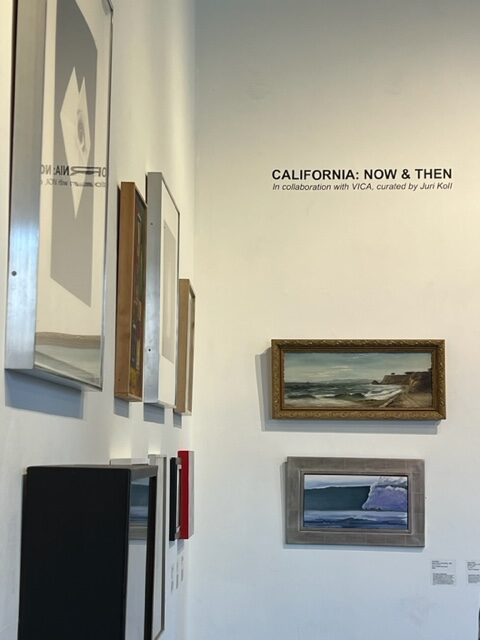
In California: Now & Then, on view at bG Gallery, curator Juri Koll takes viewers on a tour de force exhibition of California culture, environment, and of course, art. Moving from the early 20th century to 2023, among the exhibiting artists are Sam Francis, Bradford Salamon, Barbara Kolo, Catherine Ruane, Hung Viet Nguyen, Charles White, Sam Francis, Lilly Fenichel, Ulysses Jenkins, Betye Saar, May Sun, Peter Alexander, Gloriane Harris, Edmund Teske, Lyn Foulkes and more than 30 more, including work by Koll himself.
Much of the art was culled from Koll’s personal collection, while others were lent to the exhibition by the artists themselves, collectors owning the works, or museum collections. To see such a mix of stellar artworks all in one salon-style presentation at bG Gallery is a kaleidoscopic experience, a mix of abstract works with the figurative.
We see seascapes and city views, faces and geometric forms, the whimsical, the magical, and the inchoate voids. Traveling through generations of work, we see the evolution of form and color, the trends and traditions, the willingness to change, each of which characterizes California itself.
Through it all, we follow the light. One of the most fascinating finds in the exhibition is from 1904, Lockwood De Forest’s “Santa Barbara Marsh.” Suffused in gold and peach radiance, it shines like a beacon of promise, a stillness, a quiet kind of gold rush as memorable today as it was when curated. Entirely different is the abstract landscape of curator Koll’s 2023 “Käepigistus Ukraine 60,” a startlingly bright petri dish of geometric shapes seemingly swimming under an art microscope.
Gloriane Harris’ 1973 “Evening Shade” resembles a surreal moon hovering just above and just below dark periwinkle water. This is a different form of the geometric, both entirely of and transcending the period in which it was created. Evoking the same era – the quality of moving beyond the traditionally representational, reflecting the multitude of changes and restless emotion of the Vietnam years is David Alfaro Siqueiros 1972-73 color lithograph “Reclining Nude,” exuding pathos and perhaps a few bad dreams in its rhythmic brush strokes and discreet representation of body.
Beautifully current are the white lilies in Imogen Cunningham’s 1929 “Two Callas,” their fluidity and luster perfectly captured. Also cutting edge is Wynn Bullock’s 1951 gelatin silver print, “Child in the Forest,” a lush and surreal look at a child lying face down in a fecund fern-filled grove of trees. In aches with a sense of loss and wonder, a fairy tale and a cautionary tale both at once. There’s light here, too, shafting down between the trees, still and silvery. From the same year comes Hans Burkhardt’s “Untitled,” conjoins rectangles and squares dominated in golden yellows.
Sea views have always drawn me as a viewer, and there are plentiful examples here. Hank Pitcher’s 2005 “Solstice Swell at Government Point” offers lavenders and blues in a rising wave infused with a white, opalescent light. Osceola Refetoff’s radiant pink archival pigment print, created this year, is an alchemic look at “Tiny Island, Antarctica.” Hung Viet Ngyuen’s “Sacred Landscape III #18” is a fanta-sea if you will, a small 2017 oil on board work that is magical in its vibrating brush strokes, featuring both the edge of a sea or lake and a rushing river descending from dark mountains. Ruth Weisberg’s 2005 “Darkship,” a monochromatic monoprint gives viewers a ship loosed upon dark waves.
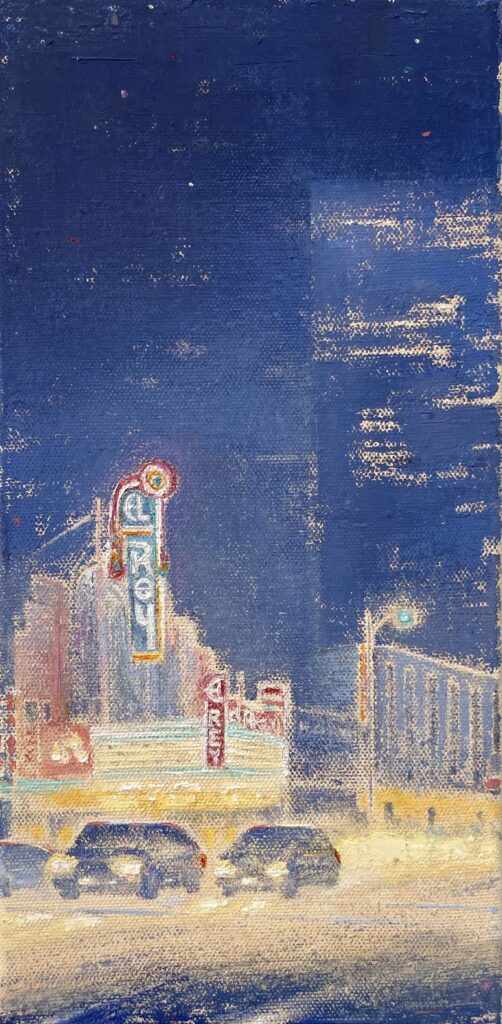
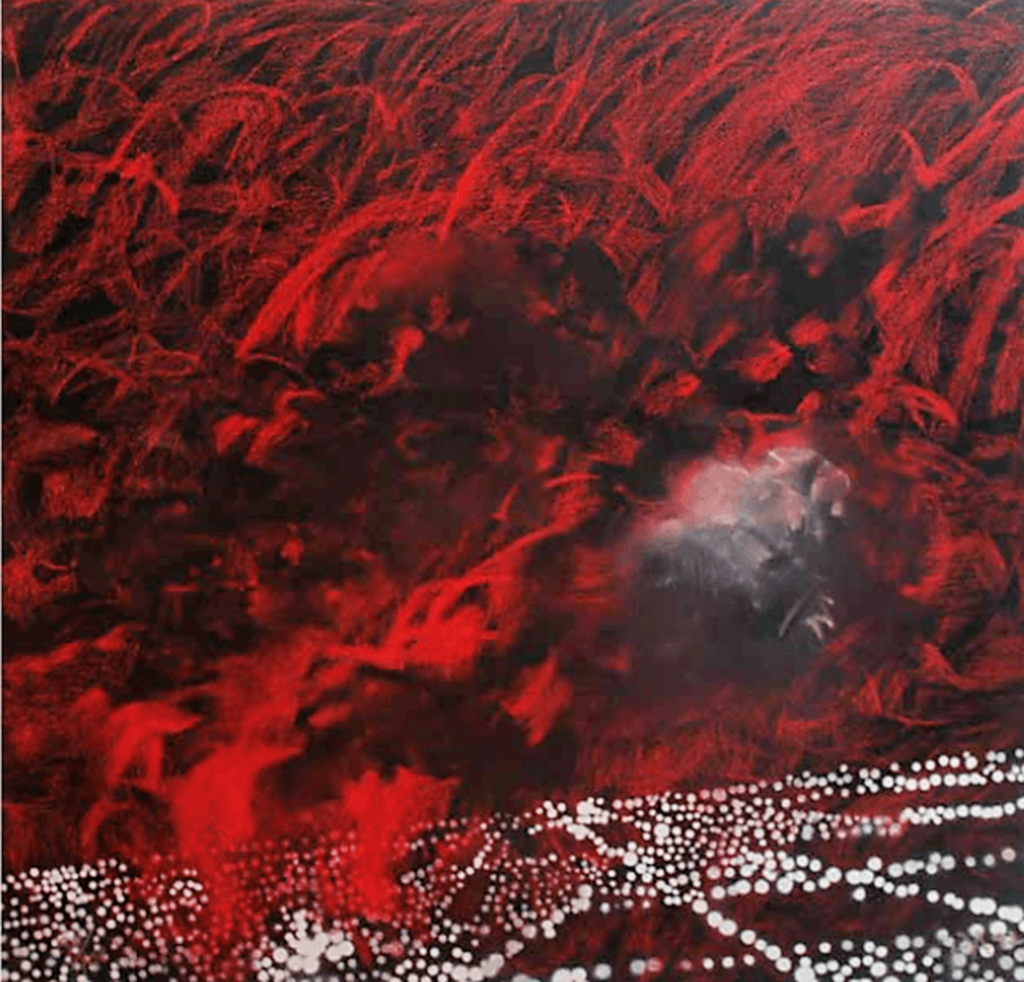
Also compelling are cityscapes such as Gay Summer Rich’s mix of headlights, lit high rise windows, and the iconic neon of the El Rey theater in her 2023 “Ready For a Night Out – El Rey.” Her carefully rendered oil on canvas, created entirely with palette knife is somehow both impressionistic and realistic at the same time, and again, the light. And, it’s also about the light – red swirling clouds above what could either be a sprawling city of dotted lights or a massive airport runway – in Peter Alexander’s 1992 “The Locus,” a surreal and absorbing mix of ink and acrylic on paper.
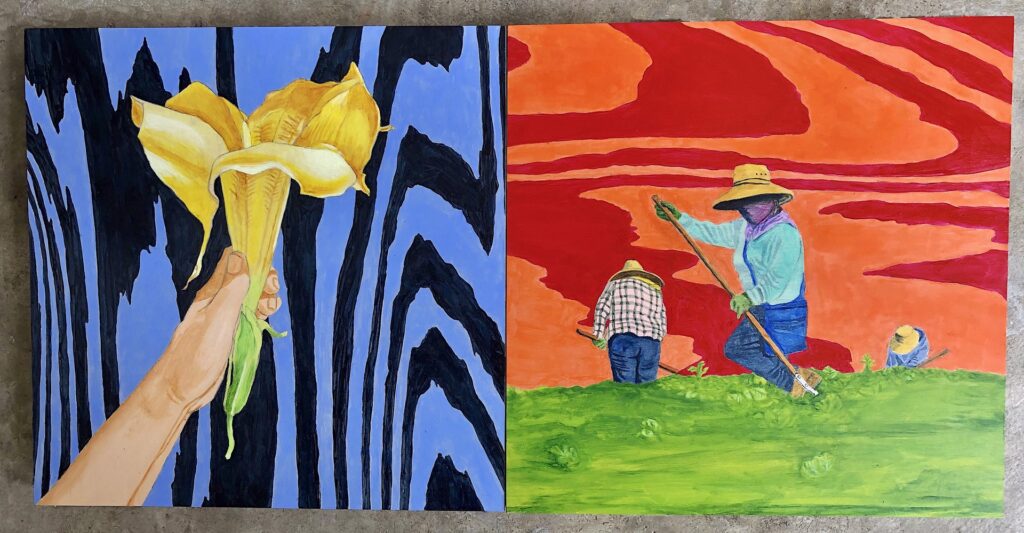
There could be nothing more bursting with light than May Sun’s 2023 “Datura (Yellow) Offering,” a diptych of acrylic on two wood panels featuring both a brilliant lily held high and the chartreuse like wave of land against with three farmworkers in yellow straw hats work, framed against a fierce orange sky. Diminutive but also exuding a burning orange is Ralph Allen Massey’s “Eight,” the letters casting deep shadows in the foreground against that sun on fire.
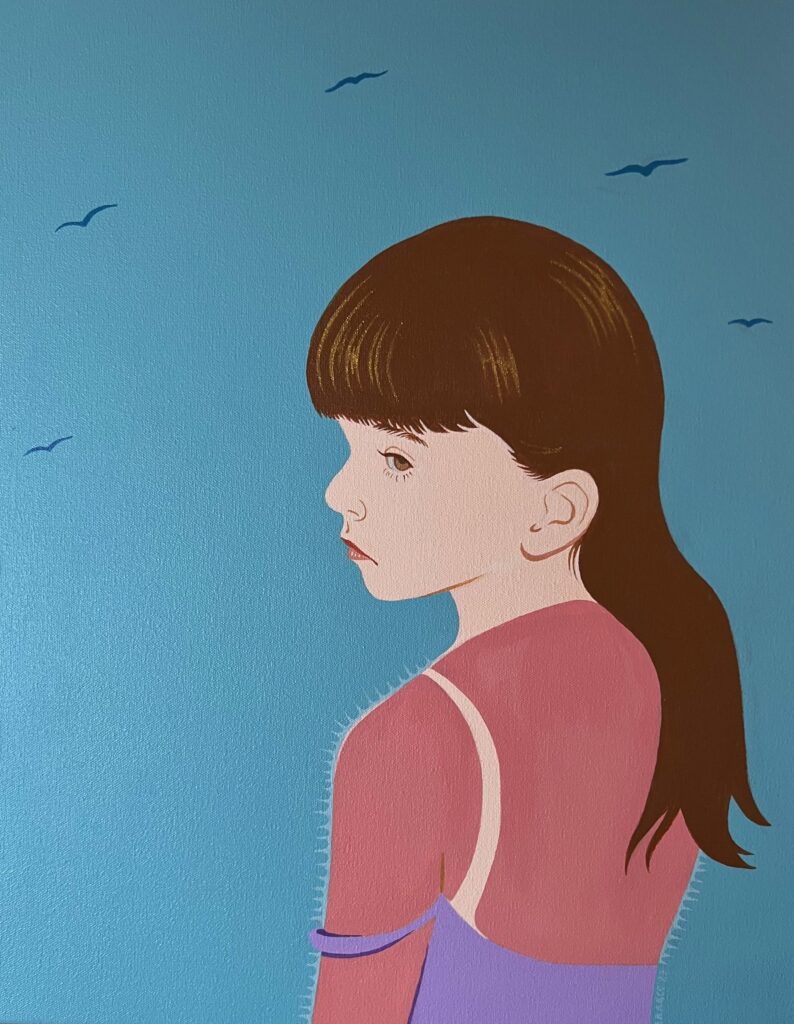
And what happens if you stand too long in the sun? The clean, stylized look of Barbara Carrasco’s sweet “Burnt Girl,” a child whose sunscreen application was sadly lacking.
There are sculptural works as well, such as Stuart Rapeport’s 2015 “Minimal Brush,” a bronze artist’s proof that resembles a magician’s wand. The sculptural stand-out in the exhibition is Sonja Schenk’s 2023 “Light for the Sun,” a floor work that combines California sandstone with stripes of 24K gold, an homage to the rich veins struck in the Gold Rush, and again, the light, the light that draws so many California transplants and dreamers, artists and writers. Comprised of three separate pieces it is a glorious work, positioned as if calling to the vast array of wall art surrounding it. Very different is the mysterious, even ominous “Studio in Dorking,” Gordon Wagner’s 1974 mixed media box, that include legs clad in hoof-like shoes and no upper half to the body attached to them. Cosimo Cavallaro’s mysterious “Black Arrow,” a 2023 work in stainless steel, absorbs and reflects the light – the antithesis to Schenk’s piece. There is also Timothy Washington’s sparkly “Many Faces, One Race” from 2019.
Some included works were startling for being so far from the same artist’s current oeuvre. This includes Catherine Ruane’s 1974 “Untitled,” her delicacy and precision of line remains the same, but this muted and intimate abstract is quite different from her charcoal and graphite roses, oak and Joshua Trees created in more recent years. Speaking of abstracts, there are a wide range to view: Larry Bell’s 1988 “Untitled,” a black orb depicted in profile against a white background, a bit reminiscent of a black hole or nuclear blast, or perhaps the emptiness of Reagan-era politics. Then there is the dancing, music-evoking 1957 “Color Sinfony,” from Oskar Fischinger; Emil Bisttram’s 1950 “Abstract,” of a plant and a beehive, everything a fluid supple motion of line; and Sam Francis’ 1976 monochrome “Untitled,” which resembles sail boats buffeted by sea spray. Max Presneil’s vibrant 2020 “MiT #149” radiates pink, red, and chartreuse persisting despite a black hole at the center left, indicative of how many felt during that year. The surreal is well represented, too, including a 2018 work by Robert Nelson, “Self-Fulfilling Prophecy.”
Bradford J. Salamon’s 2023 “Silver Spoon” gives the viewer a gold and white striped dessert confection one can almost taste, dancing in elegant light that glistens off the eponymous spoon. Its intimacy is placed comfortingly near another source of the intimate, the powerful and intimidating 2023 “Self Portrait,” from Don Bachardy, streaks of white light representing facial lines and shadows.
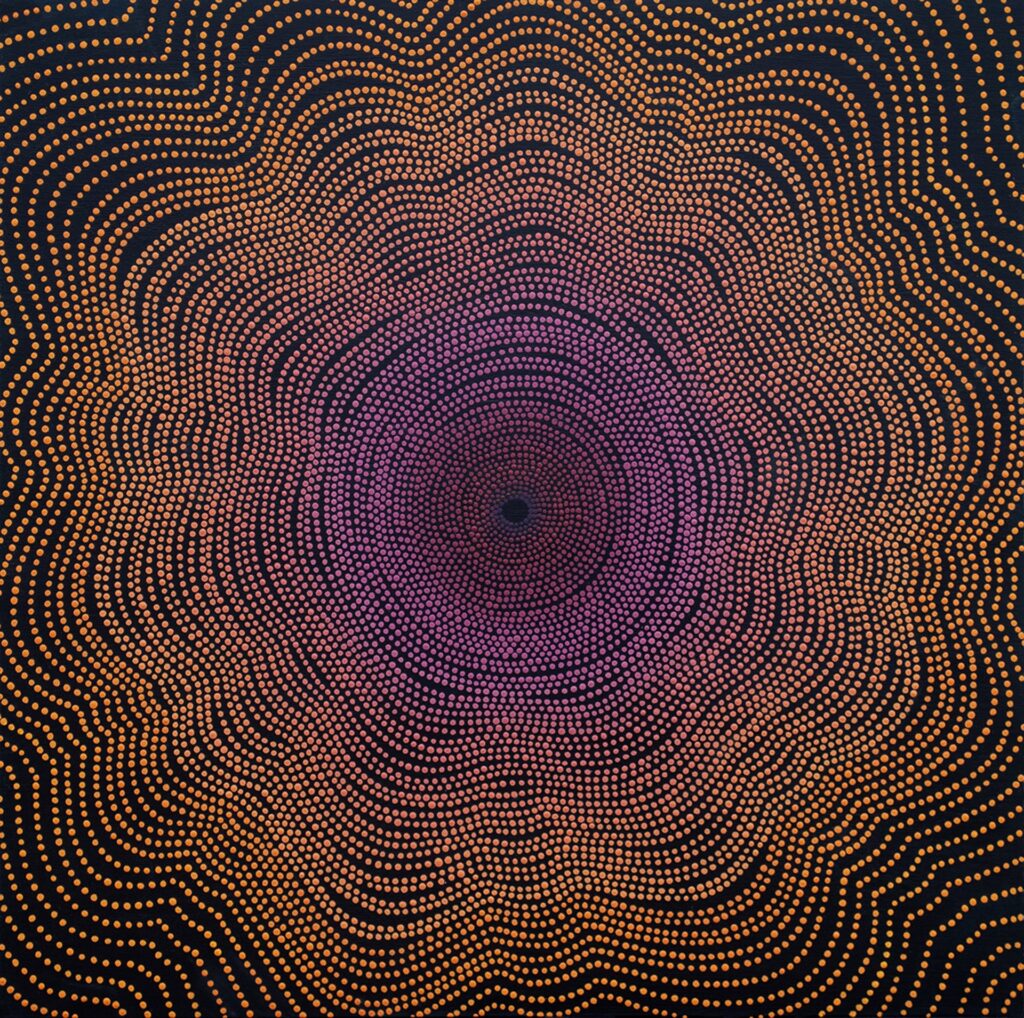
And while there are many other worthy works in the exhibition, perhaps it’s best to close with Barbara Kolo’s 2023 “Escape Into Amber,” with both the title and the minute Pointillism of her approach drawing the viewer into a vibrating flower of gold, orange, purple and red, almost as if the corona of the California sun were waiting to pull both artist and viewer deep among these unfolding petals.
The exhibition is on display at bG Gallery through August 15th. bG is located in Bergamot Station at 2525 Michigan Ave. #A2 in Santa Monica. Don’t miss.
- Genie Davis; photos: by Genie Davis and as provided by curator












































































